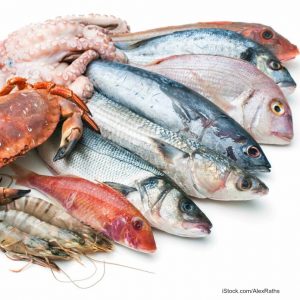The Center for Food Safety is offering tips on the best and safest seafood to eat this summer. Most seafood sold in the U.S. is imported, and less than 2% of those products are inspected for contamination. Moreover, those fish are often caught in places where environmental and health standards are weak or non-existent. By eating locally caught, sustainable seafood, you are protecting your family from foodborne illness as well as potential problems from other contaminants such as PCBs and mercury.
 Buy local if possible, and choose wild over farmed. If the seafood is farmed, choose that produced in the U.S. Favor fish caught by hook, line, handling, jig, or speargun. Avoid trawl fishing, which is destructive to the environment. Avoid fish high in mercury, PCBs, or farmed fish that are given antibiotics.
Buy local if possible, and choose wild over farmed. If the seafood is farmed, choose that produced in the U.S. Favor fish caught by hook, line, handling, jig, or speargun. Avoid trawl fishing, which is destructive to the environment. Avoid fish high in mercury, PCBs, or farmed fish that are given antibiotics.
For shellfish, farmed can be sustainable on a small scale. WIld fish are more sustainable than farmed. But remember that since shellfish are filter feeders and can accumulate toxins, check about local contaminant warnings that state and local authorities issue regularly.
Visit CFS to see a list of the best fish to eat in summer; those include Oregon pink shrimp, Pacific Halibut, Alaska wild salmon, troll and pole yellowfin tuna, troll and pole Mahi Mahi, and Yellowtail Snapper. Avoid Orange Roughy, Atlantic farmed salmon, shark, Atlantic bluefin tuna, and Atlantic cod.
Research shows that farmed fish is less healthy than wild. Fish farms use antibiotics to control disease in crowded pens. And PCBs accumulate in farmed fish at a higher rate than wild. PCBs, or polychlorinated biphenyls, are associated with the increased risk of cancer, endocrine disruption, and reproductive and development problems. Mercury accumulates in predatory or long-lived fish such as tuna, swordfish, grouper, and Chilean sea bass and can cause learning disabilities and damage to the central nervous system.
Finally, genetically engineered (GE) fish are in development around the world; avoid them if they are labeled. Those animals pose risks to wild populations of fish. Research published in the Proceedings of the National Academy of Sciences found that just 60 GE fish could eliminate a wild population of 60,000 fish in 40 fish generations. Antibiotics given to GE fish are much higher than currently farmed fish since they may be more susceptible to more diseases than wild or farmed fish.
CFS recommends that you join a Community Supported Fishery (CSF) if you eat a lot of fish. They are based on the same model as CSA, or community supported agriculture. This reduces the travel time of seafood, encourages fishermen to use less destructive methods, and distribute stocks that are discarded by the industrialized fishing industry, creating a market for plentiful seafood. Eating a variety of fish also reduces your exposure to contaminants.




